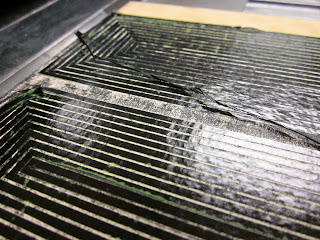20130421
PRODUCTION IS RECEPTION (56): THE NEW MANIFESTO, SECOND ITERATION (6)
As is not uncommon for NewLights books, the cover was the last part of the second iteration of The New Manifesto of the NewLights Press to be printed. The cover is almost always the last thing designed as well, and I always have to be careful not to rush through it. I’m always so much more interested in the interior (that’s where most of the work, where most of the book, is after all) and always in a hurry to get to production by the time the interior is designed. But the cover is important—it sets the stage for the reader’s initial interaction with the book.
The cover to the second iteration is set up similarly to the pages. The title uses the modular titling type (this time printed as negative space, off-white paper/letterforms against a bright medium-blue block) and a palimpsested-pentimento image printed by layering a hand-cut, vinyl collagraph over a halftone image printed from photopolymer. And, silly me, I expected the printing to actually go like the printing of the pages—simply, smoothly. Fortunately, when it came time to print the collagraphs, it didn’t work out that way.
There were, actually, some minor incidents when printing the collagraphs in the pages. I was using two kinds of blocks. One type had the adhesive vinyl applied directly to the MDF block. Those all held up beautifully. The second type, where I needed large open negative spaces and thus much higher relief on the block, used vinyl over thick chipboard, which was then attached to the MDF base. The problem with the chipboard is that it tends to come apart while printing—the layers just peel away. (One way to prevent the separation is to seal the sides of the chipboard with some kind of adhesive—I neglected to do that on these blocks.) I managed to keep the separation of the chipboard under control on the page blocks—the design of those blocks, with large, flat areas made it possible. The cover collagraph, however, had the small, repeating Stella stripes—the densest pattern in the book as a whole. It was a pain to make.
& it started to peel apart after about 6 or 7 impressions.
Initially, I fought it, tried to save it. (I was, also, of course, right up against the absolute deadline to get the covers printed & the books done for an exhibition.) It quickly became clear that it was a losing battle—as soon as one stripe was secured, another broke away.
One of the really interesting things about collagraphs is that, generally, they are made from objects-in-the-world, real things with both 2D & 3D qualities, and all of those qualities carry through into the print. Printed collagraphs become a record of a 3D object. (All printing from a physical matrix is a similar record, but most matrices are constructed to minimize their “interference” in the printed image.)
That 3D record was exactly what I saw in the prints from the degrading block. The piece of detached vinyl had moved & crumpled—it was literally printed on top of the rest of the image, and held all of its 3D properties. In the print, it looked as if the stripes in the Stella “image” were coming loose and hanging from the surface (which they were). The print oscillated between the intended, 2D articulation of the cover surface/picture plane by the stripes that were well-behaved, and the unintended, anarchic pictoriality of the peeling stripes. It was, for this book, better than I could have planned. AND because the vinyl stripes were detached, they would move with every pass of the press and print differently every time—the record would be 4 dimensional as well, spread over the edition. The only question was: would the block hold up enough, as in not peel completely away, for the entire press run?
The loose vinyl stripes were remarkably resilient (aided by a single piece of painter’s tape applied at the base of the block). They eventually would break & get stuck in the rollers:
but overall, the block both broke apart & held up beautifully for the entire run of 250+ impressions. & I was so much happier with these new, crazy, variable, unplanned covers.
& then the next day I destroyed exactly half of those covers by carelessly cutting with the guillotine.
So now I will try to reprint that second half, and hopefully the new collagraph block will fall apart just as effectively as the first….
Subscribe to:
Post Comments (Atom)

















No comments:
Post a Comment